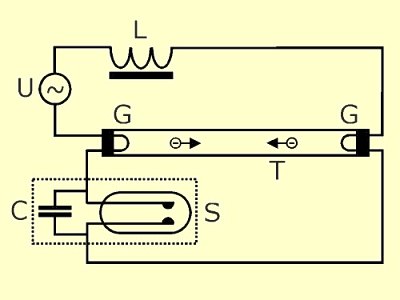TL starter
AUTOMATIC-IGNITION
An automatic ignition method that used a
combination of inductive ignition and
pre-heating of the electrodes, could be
found in tube lights (TL) and in TL based
sunlamps. Tube lights were commonly
started with a specially designed
automatic starter consisting of a small
neon glow discharge tube S and a
capacitor C. When switched on in a cold
position the full supply voltage U of (in
Europe) 230 volts AC was applied to the
gas discharge tube S of the starter
through the coil L and the two filaments
G. This caused a glow discharge in the
starter for which the coil and the two
filaments formed the current limiting
ballast. Due to the resistance of the coil
and the filaments the voltage over the
starter dropped to about 200 volts. Since
the current was still relatively small, the
filaments were hardly heated and most of
the time there was no glow discharge yet
in the tube light itself. This situation would
not alter if not one of the electrodes of
the starter was constructed as a bi-metal,
a metal strip that bended when it was heated.
The bi-metal electrode was positioned in such a way that it came in touch with the
other electrode when it bended over due to the heat of the glow discharge in the
starter, causing a complete short circuiting of the starter. The short circuit current
was only limited by the coil and the two filaments and it was large enough to make the
filaments at both ends of the tube light glow. Since the short circuiting of the starter
also terminated the glow discharge within the starter, the bi-metal electrode cooled
down and straightened again until it came loose from the other electrode. The serial
circuit of the coil L and the capacitor C now caused a voltage pulse and it was this
pulse that temporarily increased the field intensity between the two filaments G of the
tube light. Combined with the heated state of the filaments, this pulse started an arc
discharge between the two filaments of the tube light. Since a much larger electrical
current now started flowing through the tube light and the coil, the voltage over the
starter dropped to about 160V. The glow discharge tube S was dimensioned in such a
way that this voltage was not sufficient to start a new glow discharge that could bend
the bi-metal again and a steady state was reached as long as the arc discharge
within the tube light was maintained. In case the arc discharge in the tube light was
not ignited in the first cycle, the process in the starter repeated until it did.

